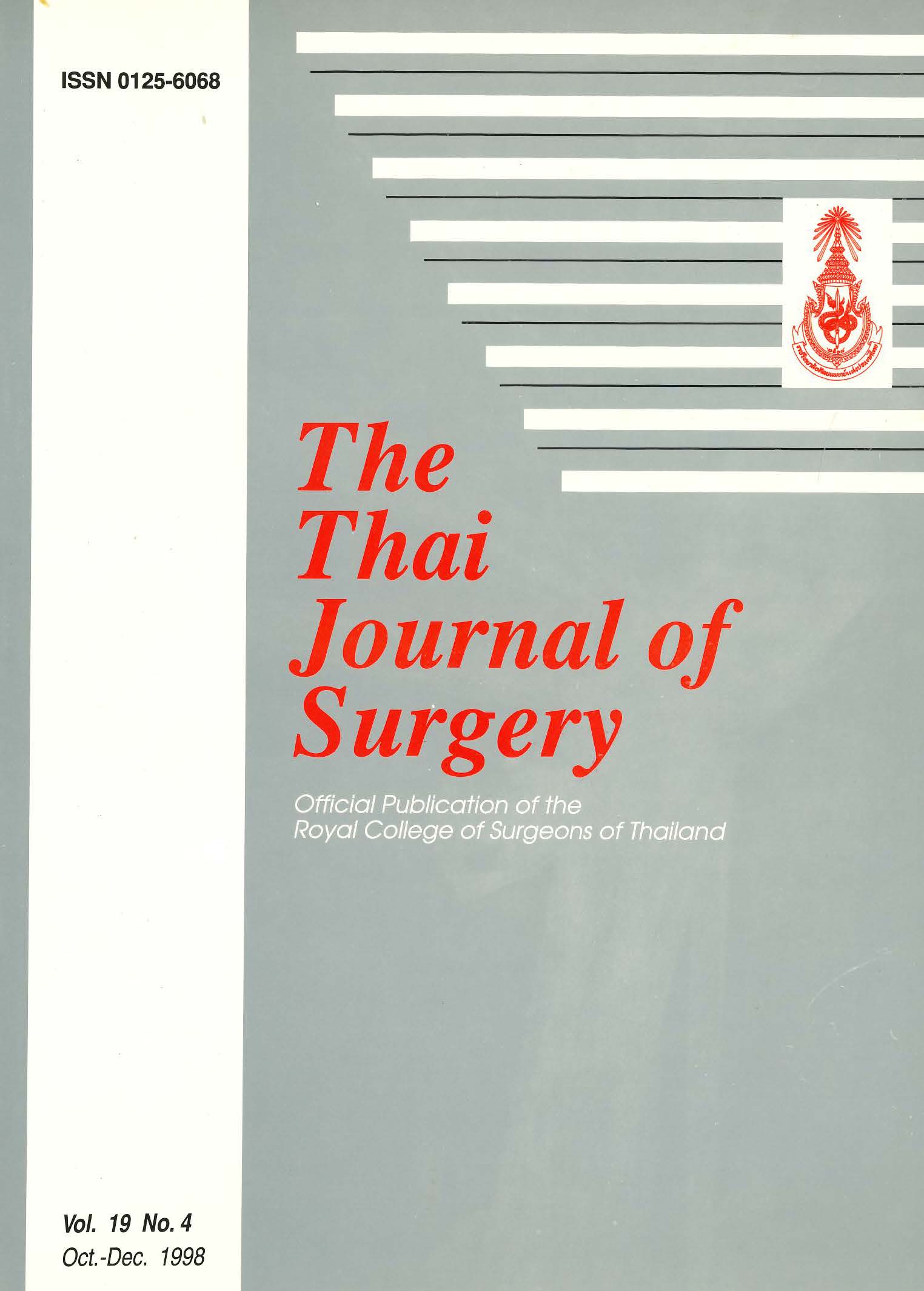Abdominal Wall Defect : A 12 – Year Experience
Abstract
During the period 1986-1 997, 457 infants with abdominal wall defects were treated at the Queen Sirikit National Institute of Child Health. Their clinical data were reviewed. Omphalocele was diagnosed in 115 patients and gastroschisis in 342 neonates. Gastroschisis occurred in thrice as often as omphalocele and was increasing in frequency in recent years. The 71 percent incidence of prematurity in association with gastroschisis was significantly greater than the 51 percent incidence in omphalocele. The greatest hazard in gastroschisis was from small defects because of pressure necrosis and bowel perforation whereas in omphalocele, the greatest hazard was associated with large defects and severe anomalies. In omphalocele, non-intestinal viscus protruding through large defects was limited to the liver. In gastroschisis, the stomach, urinary bladder, uterus and adnexa eviscerated out of the large defects. Omphalocele was frequently associated with specific upper and lower midline anomalies, Beckwith - Wiedemann and trisomy syndromes (26.1%). These syndromes were not encountered in association with gastroschisis. Intracardiac malformations were more frequent in omphalocele (31.3%) than in gastroschisis (2.3%), and they were more complex and serious. Intestinal atresias were recorded in 15 neonates with gastroschisis but was not found in omphalocele. In contrast, 15 cases of imperforate anus occurred in omphalocele while they were not present in gastroschisis. Fourteen of the 15 patients were related to bladder or cloacal exstrophy and one case had imperforate anus only. Omphalocele and gastroschisis also differed with respect to gross appearances, clinical features and response to surgical therapy.
References
2. Havanonda S. Omphalocele and Gastroschisis. Bangkok: Unity Publication, 1989: 39-42(in Thai).
3. Duhamel B. Embryology of exomphalos and allied malformations. Arch Dis Child 1963; 38:142-7.
4. Gray SW, Skandalakis JE. Embryology for Surgeons. Philadelphia : W.B. Saunders., 1972: 387-441.
5. de Vries PA. The pathogenesis of gastroschisis and omphalocele. J Pediatr Surg 1980; 15:245-51.
6. Moore TC. Gastroschisis with antenatal evisceration of intestines and urinary bladder. Ann Surg 1963; 158:263-9.
7. Raffensperger JG. Congenital defects of the gastrointestinal tract and abdominal wall : a three year review. Am J Dis Child 1975; 129:1145-50.
8. Seashore JH, Mc Naughton RJ, Talbert JL. The treatment of gastroschisis and omphalocele with biological dressings. J Pediatr Surg 1975; 10:9-17.
9. Moore TC. Gastroschisis and omphalocele : clinical differences. Surgery 1977: 82:561-8.
10. Mayer T, Block R, Matlak ME. Gastroschisis and omphalocele: an eight - year review. Ann Surg 1980; 192:783-7.
11. Tunell WP, Puffinbarger NK, Tuggle DW, et al. Abdominal wall defects in infants : survival and implications for adult life, Ann Surg 1995; 221:525-30.
12. Fonkalsrud EW. Selective repair of neonatal gastroschisis based on degree of visceroabdominal disproportion. Ann Surg 1980; 191:139-44.
13. Mabogunje OA, Mahour GH. Omphalocele and gastroschisis, Am J Surg 1984; 148:679-86.
14. Yazbeck S, Ndoye M, Khan AH, Omphalocele : a 25 – year experience. J Pediatr Surg 1986: 21:761-3.
15. DiLorenzo M, Yazbeck S, Ducharme JC. Gastroschisis : a 18 - year review. J Pediatr Surg 1987: 22:710-2.
16. Caniano DA, Brokaw B, Ginn - Pease ME. An individualized approach to the management of gastroschisis. J Pediatr Surg 1990;25:297-300.
17. Stringel G, Filler RM. Prognostic factors in omphalocele and gastroschisis. J Pediatr Surg 1979; 14:51 5-9.
18. Suita S, Sakaguchi T, Nakano H, et al. Significance of antenatal diagnosis of omphalocele. Pediatr Surg Int 1992; 7:37-40.
19. Fasching G, Mayr J, Sauer H. The effect of mode of delivery on outcome in fetuses with gastroschisis. Pediatr Surg Int 1996; 11:100-2.
20. Knight PJ, Sommer A, Clatworthy WH. Omphalocele : a prognostic classification. J Pediatr Surg 1991; 16:599-604.
21. Klein MD, Hertzier JH. Congenital defects of the abdominal wall. Surg Gynecol Obstet 1981; 152:805-8.
22. Campbell TJ, Campbell JR, Harrison MW. Selective management of omphalocele. Am J Surg 1982; 143:572-4.
23. Schwaitzberg SD, Pokorny WJ, Mc Gill CW, et al. Gastroschisis and omphalocele. Am J Surg 1982; 144:650-4.
24. Grosfeld JL, Clatworthy HW Jr. Intrauterine midgut strangulation in a gastroschisis defect. Surgery 1970; 67:51 7-19.
25. Lewis JE Jr, Kraeger RR, Danis RK. Gastroschisis : ten-year review. Arch Surg 1973; 107:218-22.
26. Grosfeld JL, Dawes L, Weber TR. Congenital abdominal wall defects : current management and survival. Surg Clin North Am 1981; 61:1037-49.
Downloads
Published
How to Cite
Issue
Section
License
Articles must be contributed solely to The Thai Journal of Surgery and when published become the property of the Royal College of Surgeons of Thailand. The Royal College of Surgeons of Thailand reserves copyright on all published materials and such materials may not be reproduced in any form without the written permission.



